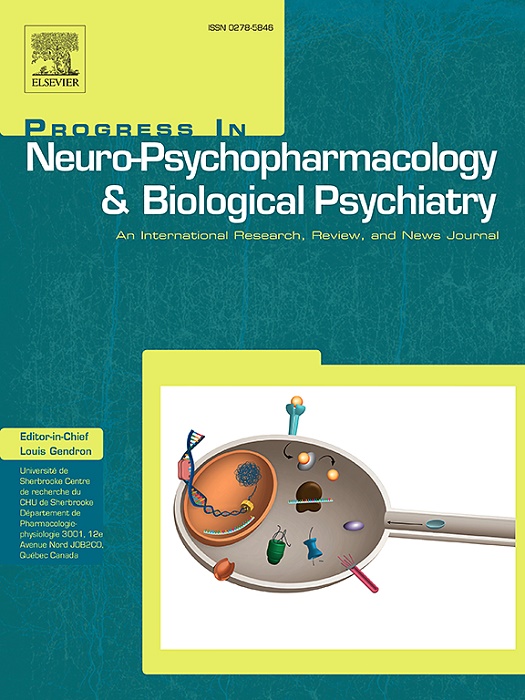白细胞介素-18在连接代谢和精神症状中的双重作用:来自精神分裂症机器学习的见解
IF 3.9
2区 医学
Q1 CLINICAL NEUROLOGY
Progress in Neuro-Psychopharmacology & Biological Psychiatry
Pub Date : 2025-08-18
DOI:10.1016/j.pnpbp.2025.111473
引用次数: 0
摘要
白介素-18 (IL-18)与代谢综合征(MetS)和精神分裂症均有关联,但其在其合并症中的双重作用尚不清楚。本研究旨在探讨在这种情况下IL-18如何与代谢和精神方面相互作用。我们招募了146名参与者,分为三组:MetS (n = 48),非MetS (n = 54)和健康对照组(n = 44)。采用阳性和阴性综合征量表评估精神症状,同时通过自动生化分析仪测量生化参数。采用Meso Scale Discovery (MSD)技术检测14种细胞因子/趋化因子的水平,包括IL-4、IL-8、IL-10、IL-13、IL-18和Eotaxin。线性回归和梯度增强机(GBM)模型显示,IL-18显著影响MetS组的代谢指标(如甘油三酯、腰围、BMI)和精神症状(如精神病理评分、攻击性评分、PANSS总分)。部分依赖图(PDP)和累积局部效应图(ALE)分析显示,IL-18与代谢标志物和临床症状具有复杂的非线性相互作用。为了进一步阐明IL-18对代谢和症状的综合影响,我们将这些标志物整合到两个总体领域:代谢和症状。然后采用极端梯度增强(XGBoost)回归模型和SHapley加性解释(SHAP)值来量化IL-18对这些域的影响。结果表明,IL-18对临床症状的影响在较低水平时更为明显,随着浓度的增加而减弱,而在较高水平时其代谢影响更为显著。这项研究强调了IL-18在共病中作为代谢失调和精神病理之间的炎症桥梁的双重作用,并强调了进一步研究驱动这些非线性相互作用的潜在机制的必要性。本文章由计算机程序翻译,如有差异,请以英文原文为准。
Dual role of Interleukin-18 in linking metabolic and psychiatric symptoms: Insights from machine learning in schizophrenia
Interleukin-18 (IL-18) has been implicated in both metabolic syndrome (MetS) and schizophrenia, but its dual role in their comorbidity remains unclear. This study aimed to explore how IL-18 interacts with metabolic and psychiatric aspects in this context. We recruited 146 participants divided into three groups: MetS (n = 48), non-MetS (n = 54), and healthy controls (n = 44). Psychiatric symptoms were assessed using the Positive and Negative Syndrome Scale, while biochemical parameters were measured via an automatic biochemistry analyzer. Levels of 14 cytokines/chemokines, including IL-4, IL-8, IL-10, IL-13, IL-18, and Eotaxin were detected using Meso Scale Discovery (MSD) technology. Linear regression and Gradient Boosting Machine (GBM) models revealed that IL-18 significantly impacted metabolic indices (e.g., triglycerides, waist circumference, BMI) and psychiatric symptoms (e.g., psychopathology score, aggressiveness score, PANSS total score) in the MetS group. Analysis using Partial Dependence Plots (PDP) and Accumulated Local Effects (ALE) plots revealed that IL-18 had complex, non-linear interactions with metabolic markers and clinical symptoms. To further elucidate the comprehensive effects of IL-18 on metabolism and symptoms, we integrated these markers into two overarching domains: metabolic and symptomatic. Extreme Gradient Boosting (XGBoost) regression models and SHapley Additive exPlanations (SHAP) values were then employed to quantify the influence of IL-18 on these domains. Results indicated that IL-18's impact on clinical symptoms was more pronounced at lower levels, diminishing as its concentration increased, while its metabolic impact was more significant at higher levels. This study highlights IL-18's dual role as an inflammatory bridge between metabolic dysregulation and psychopathology in comorbidity and underscores the need for further investigation into the underlying mechanisms driving these non-linear interactions.
求助全文
通过发布文献求助,成功后即可免费获取论文全文。
去求助
来源期刊
CiteScore
12.00
自引率
1.80%
发文量
153
审稿时长
56 days
期刊介绍:
Progress in Neuro-Psychopharmacology & Biological Psychiatry is an international and multidisciplinary journal which aims to ensure the rapid publication of authoritative reviews and research papers dealing with experimental and clinical aspects of neuro-psychopharmacology and biological psychiatry. Issues of the journal are regularly devoted wholly in or in part to a topical subject.
Progress in Neuro-Psychopharmacology & Biological Psychiatry does not publish work on the actions of biological extracts unless the pharmacological active molecular substrate and/or specific receptor binding properties of the extract compounds are elucidated.

 求助内容:
求助内容: 应助结果提醒方式:
应助结果提醒方式:


